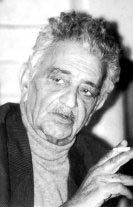

One moonless night in the summer of 1983, on a boulder off the shore of what once was Al-Zeeb, a Palestinian village north of Acre, the narrator of Emile Habiby’s haunting last novel catches a glimpse of a mysterious female figure in the sea. “The episode,” he says, “was a kind of key, like the ancient Egyptian key of life … or a magic instrument, like Aladdin’s lamp. I took it up as I began to excavate the mountains of oblivion, trying, as best I could, to penetrate the caverns of memory.” In the remarkable tale that follows, Habiby’s alter-ego—novelist, politician, devoted fisherman—struggles to discover just who or what this apparition was. Saraya, as she is known, is a character in a Palestinian legend about a young girl captured and imprisoned by an ogre. But in Habiby’s subtle, dark, and often wryly comic telling, she takes on a fluid host of roles, sometimes shifting in the course of a single page from the flesh-and-blood beloved of the hero’s childhood to a whispery symbol of the wadis and ridges around Mount Carmel to a kind of laughing muse. “Who is Saraya and who is the ogre?” he asks himself, early on. The book—equal parts allegory, folk tale, memoir, political commentary, and ode to a ruined landscape—works as an extended attempt to discover the girl’s true identity and, in doing so, to reconcile the writer (and his fictional counterpart) with the painful past of his land and his people.
Weaving the voices of several narrators—as well as meditations (by turns serious and ironic) on sources as disparate as Maxim Gorky and al-Mutanabbi, Plato and Amenhotep—Habiby’s late masterpiece is a work of tremendous power and originality. Rendered for the first time ever in English by the accomplished translator and writer Peter Theroux, Saraya is essential reading for anyone interested in the imaginative life of the Middle East.
”Habiby [is] a master, a magician, a virtuoso of complexity, as readers of English are now able to discover in Peter Theroux’s translation…. [Saraya, the Ogre’s Daughter] is amazing. Read it … and see the world around us here, and everywhere, with new eyes.”
Ha’aretz
”Habiby’s quest takes him into Arab myth, his own past, and the causes and outcomes of the violence that has plagued the Middle East. Habiby writes passionately of the predicament of Arabs in Israel and the Palestinian diaspora…. Peter Theroux’s expert translation makes accessible to English readers the author’s delight in the Arabic language.”
Publishers Weekly
”An homage to the ways imagination, proverbs, and legends help us discern the truth, even as adults… The narrative is fiercely original at the same time it’s an importunate reinvention, breathing life into the past to see what remains possible … [Saraya] is a parable of life set to the music of bombs.”
The Chicago Tribune
”From his stories of the fifties through Saraya of the nineties, Emile Habiby wrote one long magisterial elegy, to the lost Haifa, the place of his birth, and the city in which he remained; to his vanished homeland—its brooks and shores, and fish and rocks and stones, its soil, trees, and grasses, its buildings and homes, streets and paths, and its visible and hidden landscapes; to its cities and villages, destroyed and still standing; and especially to its names that have been erased. But his writing, in the end, bestows upon the Palestinians a “national home” far more magnificent and beautiful and indelible than all the houses they have been “promised” throughout their erased history.”
Anton Shammas
“In Arabic, Habiby had no precursors and has had no successors.… Acknowledging his debt to Voltaire and Swift, he has proven inimitable.”
Middle East Magazine
“He remained where he was born, in the place where he preserved, uninterrupted, the innate and constant organic link between the land, its history, and language; where he continued to listen with awe, humility, and love to the dialogue of heaven and earth, in order to live his simple life, satisfied with his share of water, air, and light, and the succession of seasons and invasions, so that the land, which lost its nature, might become the land of multiplicity, tolerance, and peace.”
Mahmoud Darwish
EMILE HABIBY, born in 1921, was one of the greatest Arabic novelists of his time. Among the founders of the Israeli Communist party, a member of Knesset, journalist, the long-time editor of the party newspaper al-Ittihad, founder of the literary journal Masharef, and an outspoken proponent of Arab-Jewish co-existence, Habiby was strongly identified with the city of Haifa and its surroundings. His books include the classic satirical novel The Pessoptimist (1974), Ihtaya (1986), Saraya (1991), and a collection of stories about the 1967 war. He was granted the highest honors accorded by the two societies in which he lived: the al-Quds Award and the Israel Prize, which he chose to accept, a decision that gave rise to considerable controversy. He died in 1996.
PETER THEROUX is widely acknowledged as one of the leading English-language translators from Arabic. He has translated numerous novels, including Children of the Alley by Naguib Mahfouz and the Cities of Salt trilogy by Abdelrahman Munif. He is the author of The Strange Disappearance of Imam Moussa Sadr, Sandstorms: Days and Nights in Arabia, and Translating LA: A Tour of the Rainbow City and has written for Vanity Fair and National Geographic. He lives in Washington, D.C.
Available from Small Press Distribution in Berkeley, CA. To Order: click here
Also available from Adraba Books, Jerusalem: adraba@adrababooks.co.il